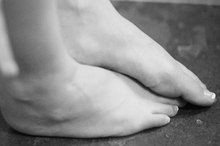What does fact checked mean?
At Healthfully, we strive to deliver objective content that is accurate and up-to-date. Our team periodically reviews articles in order to ensure content quality. The sources cited below consist of evidence from peer-reviewed journals, prominent medical organizations, academic associations, and government data.
- National Center for Biotechnology Information: Evidence for a Distinctive Pattern of Bone Formation in Enthesophytes
- National Center for Biotechnology Information: Evidence for a Distinctive Pattern of Bone Formation in Enthesophytes
- Wiley: The Formation of Bony Spurs (Enthesophytes) in the Achilles Tendon
The information contained on this site is for informational purposes only, and should not be used as a substitute for the advice of a professional health care provider. Please check with the appropriate physician regarding health questions and concerns. Although we strive to deliver accurate and up-to-date information, no guarantee to that effect is made.
What Is Plantar Calcaneal Enthesophyte?
Plantar is derived from the Latin word planta, which refers to the sole of the foot. Plantar ailments are painful because the sole bears the whole weight of the body while walking. Plantar calcaneal enthesophyte is such an ailment.
If you are experiencing serious medical symptoms, seek emergency treatment immediately.
Etymology and Meaning
The Latin word calcaneum refers to the heel. The word enthesophyte combines the two Greek words enthesis, meaning an insertion, and phyton, meaning something that is grown, so a plantar calcaneal enthesophyte is a growth that occurs at the place where a tendon inserts into the heel bone on the bottom of the foot, according to the American Journal of Roentgenology 1.
Nature of Growth
What Are the Causes of Lateral Foot Pain?
Learn More
The enthesophyte growth is osseous or bony in nature 3. It is popularly called a spur. Enthesophytes typically begin to develop at an enthesis, or point of tendon or ligament attachment. Enthesophytes then enter the tissue of the attached tendon or ligament, according to Arthritis and Rheumatism.
- The enthesophyte growth is osseous or bony in nature 3.
- Enthesophytes then enter the tissue of the attached tendon or ligament, according to Arthritis and Rheumatism.
Precise Location
Plantar calcaneal enthesophytes occur at the calcaneal attachment point of the flexor digitorum brevis, a muscle that flexes the toes, and the abductor hallucis, a muscle that moves the big toe sideways away from the rest of the toes, according to the American Journal of Roentgenology 1. They also occur above the sturdy tissue that lines the bottom of the foot and sometimes in this tissue, according to Skeletal Radiology.
Related Articles
References
- American Journal of Roentgenology: Disorders of the Plantar Aponeurosis
- National Center for Biotechnology Information: Evidence for a Distinctive Pattern of Bone Formation in Enthesophytes
- Wiley: The Formation of Bony Spurs (Enthesophytes) in the Achilles Tendon
- "Liddell and Scott's Greek-English Lexicon"; Rev. James M. Whiton, editor; 1871








